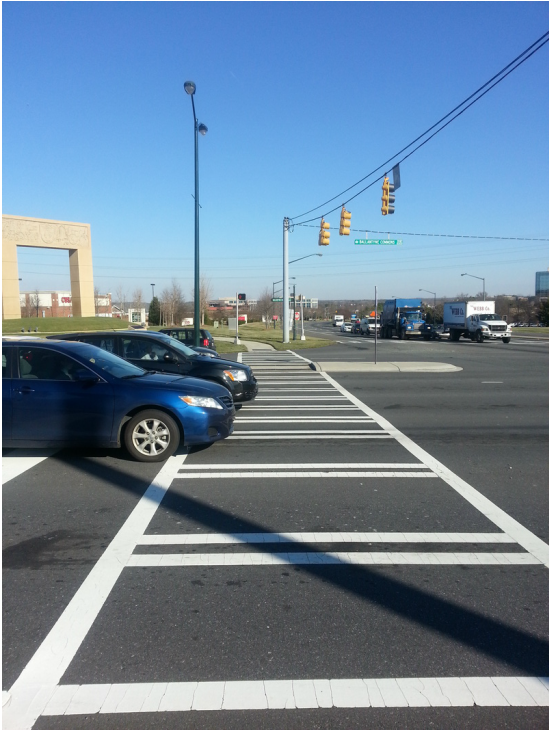First of all Dave, my apologies for this taking so long. Charlotte is a bundle of contradictions from a walking perspective and I have been struggling to express my feelings and thoughts about it. BUT this week we went to a talk by author and international planning consultant Jarrett Walker. Dr. Walker specializes in public transport issues and articulated much of what I felt but couldn't find the words to express.
To start at the beginning of our Charlotte story the reason we were there was to help out a friend who had recently had surgery and couldn't drive. This particular week he was home alone and was feeling the loss of his mobility keenly. This brings me to one of the first points Jarrett Walker made. The ability to get around is freedom. To me freedom is the ability to walk so the better the walkability of a place the more freedom I have. To our friend freedom is the ability to drive. The difference in our views is partly just because of who we are but it is also tied to where we live. If our friend was in New York City he would not have felt as trapped as he did in Charlotte.
A little bit of background on Charlotte. It was incorporated in 1768, trundled along for many years and then recently erupted both upward and outwards. It is the hub for US Airways, boasts an international airport, and is now one of the largest centers of financial services in the country. It has an historic center, a lot of new high rise tower office blocks (known as uptown, not downtown) and a LOT of suburban sprawl that seems to grow between every visit we make.
We were staying just inside the 485 ring road (for those who like visuals, see map) in one of the suburban developments that surround the city center. I believe that Charlotte is trying to become more transit oriented and walking friendly. There is a light rail with more routes planned, there are over 70 bus routes and most suburban roads we traveled have sidewalks, but it feels like the city's transport plan is suffering from a prolonged stutter. Developers build neighborhoods - these are not gated communities but they are distinct separate developments. And most if not all of these neighborhoods have a shopping center nearby. Some of the shopping centers are quite large and the ones we've seen are truly just shopping centers. I have not seen a library, a community center, nor an art gallery in any of these. Technically, these centers are close enough to walk to and many of the developments have sidewalks as they are no doubt required to include. Some of the sidewalks are hard to see because developers like to screen them, making pretty winding paths through the trees. This brings me to another point made by Dr. Walker. Paths like these are part of what he refers to as transportation designed for people of leisure NOT for people trying to get someplace. Pedestrians who are wanting to get someplace as opposed to going out for a stroll with their dog, will generally take the shortest, easiest route. Like water. This is how we end up with desire lines - paths people choose to walk that are not where sidewalks have been provided.
After walking through a development -on the sidewalk, on the road, or in between - the next part of walking to the nearest shopping center is almost inevitably along an arterial road. Charlotte engineers clearly 'do' roads and they make them BIG (they of course have congestion because big roads don't solve congestion but that's a separate topic). The picture below shows an intersection we walked around that I consider typical for the area. The traffic engineers have tried to do right by pedestrians. There is an island in the middle of the intersection to make it safe for those who get stranded in the middle. There are sidewalks. But it is not what I would call congenial nor friendly. Look at those cars getting ready to race as soon as the light changes! It felt like crossing in front of the starting line at a race track.
Time for a note about transit - because it is so important to walkability and because it is also important in relation to freedom, the point that this post started with. Dr. Walker talks of efficiency equaling abundance. And in the suburbs of Charlotte, despite the 70 plus bus routes, buses are rarely sighted which tells me that the services are not abundant. The City bus schedule shows that the Providence Road bus runs about every 45 minutes on weekdays, every hour on Sundays and surprisingly every half an hour on Saturdays. I don't know what is behind the Saturday increase - shopping? sport? low income workers? Whatever the case Dr. Walker explains the effect of infrequent transit services to drivers by saying "imagine if the gate to your driveway only opened once an hour". Infrequent and/or poor coverage transit service does not equal freedom.
All of these points are what, I believe, left our friend feeling his loss of freedom so strongly when he was unable to drive. Infrequent, inconvenient transit, no easily accessible taxis, and no real sense of being able to walk anywhere other than a single shopping center along an arterial road.
I can't close without mentioning that Charlotte does have a wonderful greenway. Right now it is also stuttering so it is not a commuter's paradise yet but the plans are there and once the dots and dashes are connected it will be phenomenal. Even now it is fantastic to walk or cycle along and makes some wonderful wetland areas accessible.
So Dave, do you agree?

 RSS Feed
RSS Feed
